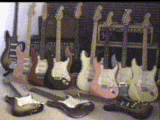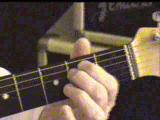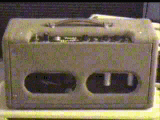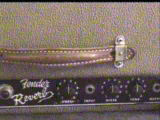Instructor Wolf Marshall

Wolf Marshall:
First the gear. Check out these Strats!! These are a few of my favorite Strats. L to R: 1970
Paisley Strat, 1988 Candy Apple Red 12-String Strat
(very rare), 1987 Black American Standard Strat Plus, 1989 Salmon
Pink Custom Shop Strat, 1976 White Strat, 1960 Metallic
Pink, 1987 Sea Foam Green Custom Shop, Blonde Strat with
1957 neck. On the floor: R to L.
1996 SRV Strat, 1992 Purple Jeff Beck
Strat...and 1964 Sunburst Strat.
Background: Bass VI, 1965 Twin-Reverb Amp, 1961 Bandmaster,
and 1961 Reverb unit.
Wolf with favorite Strats

Wolf Marshall:
I thought I'd give you the rundown. Here's an exercise with a chord and a riff to help you play the first lick.
Wolf Marshall:
You hold the E minor and simultaneously play a muted riff on the bass strings.
E Minor Chord

Wolf Marshall:
This will prep you for the basic technique.
jammer:
I notice you finger this chord different than I do
Wolf Marshall:
Jammer. You have to do hold the chord and play the riff. It's a polyphonic thing.
ginnym:
polyphonic?
Wolf Marshall:
Gin. Yes. Chord sustaining plus moving bass notes.
jammer:
Wolf, how do you pick this lick?
Wolf Marshall:
Jammer. Upstum for chord. Down strokes for bass notes. This lick has HEAVY REVERB!!!
irene:
sounds like a dick dale songs
ginnym:
is like Dick Dale He's the king of surf !
jammer:
sure does, do you have any exercises for double picking?
Wolf Marshall:
A lot of surf music is Dale influenced. Double picking is coming up in the third lick. Stand by, jammer.
ginnym:
I heard Dick say that he uses really, really heavy gauge strings
Wolf Marshall:
Gin. He does. Strat necks are pretty strong. Here's a pic or two of the old Fender Reverb unit.
'61 Fender Reverb (Front)

'61 Reverb Back

Wolf Marshall:
All, reverb is part of the surf sound---makes music sound wet.
'61 Reverb (Controls)

JoeyC:
now those are real reverb units...tubes and all
Wolf Marshall:
1961 Fender Reverb Unit.
Cocoa brown tolex, wheat grill cloth. Brown panel, brown knobs.
All tube: 12AT7 preamp, 6K6 driver, 7025 reverb recovery.
Hammond Organ reverb spring system. These are still a good buy when you can find them...and they are also reissued.
Control Panel: 1961 Fender tube Reverb unit.
Pilot light, Dwell (amount of 'verb effect), Input,
Mixer (proportion or ratio of effect in relation to
dry signal), Tone (Bass or treble in effect), Output. Here comes another one
Wolf Marshall:
This one has the famous surf bar bend. Here's a close-up of the bar bending technique.
Wolf Marshall:
The bar is essential to this style of surf.
ginnym:
Tubes, a classic 30
Wolf Marshall:
Most tube amps will sound good as a starting point. Then add tons of reverb
Danny:
didn't Dick Dale play his guitar with the heavy strings on the bottom of the neck?
Wolf Marshall:
He used heavier strings in general. You have to set the guitar up for them.
Danny:
I mean the strings were upside-down, since he was left-handed
Wolf Marshall:
Danny--that's right. Like Albert King.
irene:
wasn't that hendrix that played upside down?
Wolf Marshall:
Actually Jimi usually reversed the strings. Dick Dale pulled down to bend higher pitched strings.
'61 Fender Bandmaster

Wolf Marshall:
1961 Fender Bandmaster Amp.
First year of the Fender piggy-back amps!
White tolex, maroon cloth, brown panel, white knobs,
2 x 12 cabinet, tilt-back legs. All tube five-stage
tremolo. 5881 power tubes.
Controls:
Normal Channel: Volume, Treble, Bass.
Vibrato Channel: Volume, Treble, Bass, Speed & Intensity
for tremolo effect. Master Presence control.
Same amp as the 3 x10 Bandmaster combo. These are pics to show the actual gear for flavor and authenticity. It's hard to see these anymore.
Here comes Lick 3. It'll wipe you out.
BruceB:
Wolf, do you try not to rest your hand on the trem? I use 10s and a fairly stiff setup, but for the surf stuff it's easy to go out of tune.
Wolf Marshall:
Bruce, be gentle, actually you just back off slightly. This is an Em jam track to practice
Wolf Marshall:
You can play the first three licks over this E minor groove. Try all three over E minor groove.
The palm muting example shows how to rest your hand for the Pipeline tone
ginnym:
I used to have trouble w/ palm muting. It improved when I got my strat though. easier w/ a floating trem.
Wolf Marshall:
Gin--that's interesting. Many have trouble with the bridge. The palm muting tech is also essential to surf guitar.
That pink Strat is set up with a floating trem. The next lick is a tremolo picking extravaganza.
Danny:
what scale is in?
Wolf Marshall:
Danny, that's the E Phrygian Major E-F-G#-A-B-C-D#, those were the scale tones. It's like a major and Phrygian put together.
Danny:
kinda gypsy sounding
Tom:
sounds a little like spagetti western music
Wolf Marshall:
Danny, that's right--surf music used those Middle Eastern scale sounds.
ginnym:
do you use just one finger on the single notes? or no
Wolf Marshall:
Gin, you use a couple of different fingers..index and middle for most
jammer:
what are the notes again, I'm unclear if it's the Phrygian or a combination of Phrygian and Major?
Wolf Marshall:
Jammer, here's how it works. The scale is E-F-G#-A-B-C-D#. Phrygian would be E-F-G-A-B-C-D. Major is E-F#-G#-A-B-C#-D#. Those are the two sources.
It's like the Phrygian Dominant with a D# instead of D
Danny:
F#?
Wolf Marshall:
Danny, yes. That gives it the Phrygian sound. That's the crucial note. It has characteristics of both scales.
ginnym:
the beginning sounds major the end sounds minor? is that right? Phrygian? can you give a brief explanation of that.
Wolf Marshall:
Gin, sure. Phrygian is the mode built on the third step of a major scale. In C, E is the third step: C-D-E.
So begin on E. You have E-F-G-A-B-C-D.
ginnym:
right . I do know my major scales. COOL, I get it
Wolf Marshall:
That's pure Phrygian, Now with the Phrygian Major. Make G into G# and D into D#
jammer:
Wolf are there any exotic scales that match these scale tones, like spanish gypsy, jewish, gypsy minor, whatever they call them
Wolf Marshall:
Jammer, some of those names are colorful but aren't always accurately used or agreed on.
See you all next week. Bring your blues axes
|
<< load notation from left
|